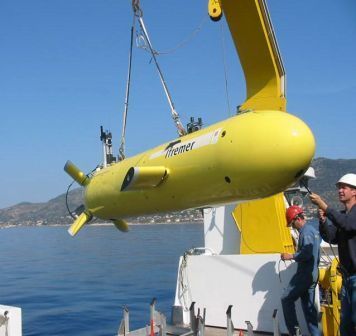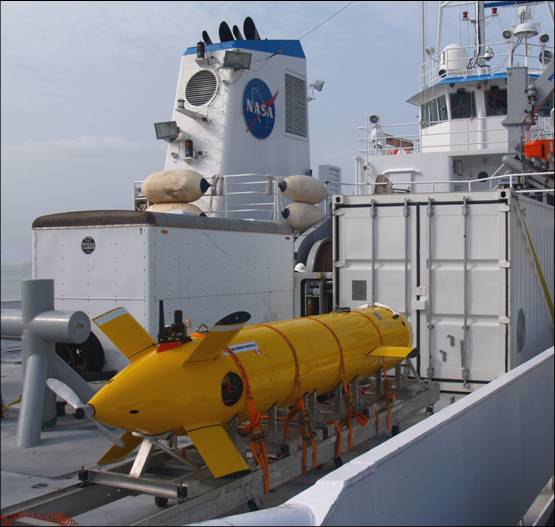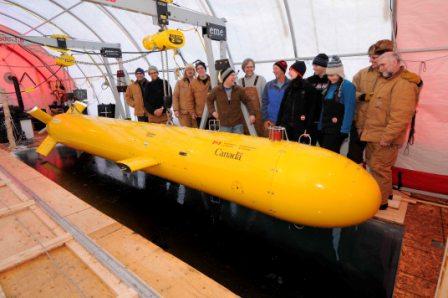
 |
Home Products Services About Us Contact Us |
 |
|
ISE develops & manufactures Autonomous Underwater Vehicles (AUVs) Fully submersible AUVs are underwater vehicles which can operate below the sea surface without any physical connection or communication with a control station. They are pre-programmed to execute missions and have a small amount of “intelligence” or the ability to make simple decisions. They are appropriate for underwater missions such as seabed surveying where the vehicle must cover long distances at relatively slow speeds – between 1 and 2.5 meters per second. ISER has been involved in fully submersible AUV development since 1981. It all started with the prototype ARCS vehicle, and THESEUS - the largest AUV in the world.   Current AUV Development - EXPLORER The Explorer class of AUV is a modular vehicle comprising of a forward free-flooding section, full diameter pressure hull and a free flooding aft section. It is optimized for longevity and can be adapted to meet new requirements. It is available in many configurations and depth ratings from 300 to 6000 m. Vehicle systems and payload sensors can be customized at any time throughout the vehicle's life. Payload equipment can be fitted in either of the free-flooding sections, with the associated electronics installed inside the pressure hull on a standard 19 inch rack. The wet payload can include sidescan sonar, multibeam echosounder and sub-bottom profiler, all of which can operate concurrently. Payload data is easily accessible though a high speed Ethernet connection. The Explorer AUV is renowned for its low operating costs, flexibility and exceptional long range unsupervised capability. In the spring of 2010, an Explorer completed more than 10 days of continuous operations under ice, covering more than 1000 km of unsupervised survey without being recovered. Charging and data transfer all took place underwater. The Explorer is also a very stable sensor platform, with a maximum deviation of 0.2º per second in roll, pitch and yaw. Explorer AUVs are owned and operated by the French research agency Ifremer (2 vehicles), the University of Southern Mississippi as part of a NOAA project, Memorial University of Newfoundland, the University of Bremen and Natural Resources Canada (2 vehicles). The Explorer AUV has been well received by the scientific community around the globe. Recently ISE delivered a second Explorer AUV to Ifremer in France, one to Memorial University of Newfoundland in Canada and one 5,000 metre vehicle to the University of Bremen in Germany. We also built an Explorer for the National Oceanic and Atmospheric Agency in the USA. That vehicle is jointly operated by the University of Southern Mississippi and the University of Mississippi.
This image above comes to us from Kraken Sonar Systems Inc. from St John's, Newfoundland. It was taken during operations of the Natural Resource Canada (NRCan) Arctic Explorer AUV operating at Defence Research and Development Canada (DRDC). Check out the discarded automobiles in Bedford Basin imaged with AquaPix - an interferometric 300 kHz wideband synthetic aperture sonar at a water depth of approximately 65 meters.Click here for the ISE Explorer Datasheet. The Arctic Explorer AUV The Arctic Explorer is a derivative of the successful Explorer AUV that was first designed in 2001. ISE has built two Arctic Explorers for Natural Resources Canada to map the sea floor underneath the Arctic ice shelf in support of Canada's claim under Article 76 of the United Nations Convention on the Law of the Sea. In April 2010, one of these vehicles completed over 1000 km of under-ice survey, mapping the sea floor during 10 days of continuous underwater operation. The Arctic Explorer can be launched from a ship or an ice-hole and the modular sections can be separated for transportation. The Arctic Explorer is the largest of the Explorer AUV class, measuring over 7 m long and weighing over 2000 kg. It is equipped with an extended range capability, making 80 missions covering 450 km possible. The Arctic Explorer has a unique variable ballast system that enables it to park on the sea floor or hold itself on the underside of the ice during the mission. It is rated to 5000 m depth and is designed to remain underwater between missions with all servicing and charging being carried out by a small portable ROV. 
Click here for the ISE Arctic Explorer Datasheet. Semi-Submersible AUVs Semi- submersible AUVs are underwater vehicles which can operate just below the sea surface without any physical connection with a control station. Generally, they are in continuous communication with the control station although they operate in the same pre-programmed manner as the fully submersible AUV. Because they operate just below the surface, a surface piercing mast allows air to be drawn into the vehicle and a diesel engine to be used. Since the vehicle does not carry it�s oxidant, the power plant is far more efficient and higher speeds are possible. Semi-submersible AUVs are appropriate for a variety missions such as shallow water surveying or towing where the vehicle must cover long distances at reasonably high speeds � between 2 and 10 meters per second. The semi-submersible AUV was invented by ISE in 1981.Towfish The towfish is a towed underwater vehicle capable of carrying imaging sonars and other marine sensors. Unlike many towed vehicles, it is designed specifically to operate at high speeds (18 to 30 kph). It was developed and tested between 1997 and 1999. The intellectual property associated with the towfish is owned completely by ISE.
New Generation Aurora Development of the new generation of commercialized ISE Aurora Towfish was completed in 2014. As a towfish, Aurora has been designed with a large, actively controlled main wing to control depth. The Aurora Towfish is designed to operate at speeds of up to 12 knots. |
| © 2015 International Submarine Engineering Limited All Rights Reserved. |